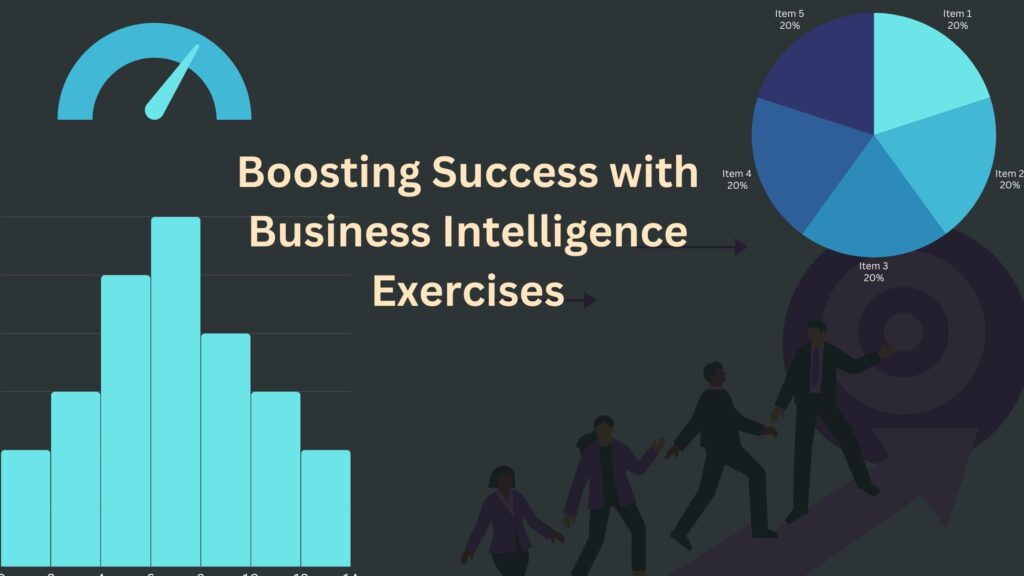Business intelligence (BI) has become an essential aspect of modern business strategy, enabling organizations to leverage data to make informed business decisions. By employing various BI tools and analytical techniques, companies can gain valuable insights, improve efficiency, and drive growth. One critical aspect of implementing BI effectively is engaging in business intelligence exercises, which encompass a range of activities and training methods aimed at improving the skills and capabilities of teams in data analysis and BI tool utilization. This article delves into the importance of business intelligence exercises, their components, and how they contribute to better business decision-making.
Understanding Business Intelligence
Business intelligence involves the use of technologies, processes, and practices to collect, integrate, analyze, and present business information. The primary goal is to support better decision-making within an organization. BI encompasses various functions, including reporting, online analytical processing (OLAP), data mining, process mining, complex event processing, business performance management, benchmarking, text mining, and predictive analytics.
Importance of Business Intelligence Exercises
BI exercises are designed to train individuals and teams in the effective use of BI tools and techniques. These exercises play a crucial role in:
- Enhancing Data Literacy: Helping employees understand data, its sources, and how to interpret it.
- Improving Analytical Skills: Developing the ability to analyze data accurately and derive actionable insights.
- Familiarizing with BI Tools: Ensuring that team members are proficient in using various BI tools and software.
- Supporting Business Decision-Making: Providing the necessary skills to make data-driven business decisions.
Components of Business Intelligence Exercises
BI exercises can be categorized into several key components, each aimed at developing specific skills and knowledge.
Data Collection and Integration
The first step in any BI process is data collection. BI exercises in this area focus on:
- Identifying data sources.
- Collecting data from various internal and external sources.
- Integrating data into a unified system for analysis.
Data Analysis and Interpretation
Once data is collected and integrated, the next step is analysis. Exercises here involve:
- Using analytical tools to process data.
- Interpreting data to extract meaningful insights.
- Understanding different types of data analysis, including descriptive, predictive, and prescriptive analysis.
Familiarity with BI Tools
BI tools are software applications used to retrieve, analyze, transform, and report data for business intelligence. Common BI tools include:
- Tableau: Known for its robust visualization capabilities.
- Power BI: Microsoft’s powerful tool for data analytics and visualization.
- QlikView: Offers guided analytics solutions and self-service BI.
- SAP BusinessObjects: Comprehensive suite for business intelligence solutions.
BI exercises help users become proficient in these tools by providing hands-on experience and practical training.
Scenario-Based Training
Practical, scenario-based training is an effective way to apply BI skills in real-world situations. These exercises simulate real business problems, requiring participants to use their BI knowledge to:
- Analyze data.
- Identify trends and patterns.
- Make informed business decisions.
Benefits of BI Training
Investing in BI training through structured exercises offers numerous benefits to organizations:
Improved Decision-Making
With better data analysis skills and familiarity with BI tools, employees can make more informed decisions. This leads to:
- Increased accuracy in business decisions.
- Reduced risks by anticipating future trends and challenges.
- Enhanced strategic planning and operational efficiency.
Enhanced Competitiveness
Companies that effectively use BI are better positioned to outperform competitors. By leveraging data to gain insights into market trends, customer behavior, and operational efficiencies, businesses can:
- Identify new opportunities.
- Optimize processes.
- Enhance customer satisfaction.
Increased Employee Engagement
BI training and exercises can boost employee morale and engagement. By investing in their development, organizations show that they value their workforce, leading to:
- Increased job satisfaction.
- Higher retention rates.
- Improved overall productivity.
Implementing Business Intelligence Exercises
To effectively implement BI exercises, organizations should consider the following steps:
Assess Current Capabilities
Before starting BI training, it’s essential to assess the current capabilities of the team. This involves:
- Evaluating existing knowledge and skills.
- Identifying gaps and areas for improvement.
- Understanding the specific BI needs of the organization.
Develop a Training Plan
Based on the assessment, develop a comprehensive training plan that includes:
- Clear objectives and goals.
- A detailed curriculum covering all relevant BI topics.
- A mix of theoretical and practical training sessions.
Utilize Expert Trainers
Engage experienced trainers who have extensive knowledge of BI tools and techniques. Expert trainers can provide:
- In-depth knowledge and insights.
- Real-world examples and case studies.
- Hands-on training sessions.
Monitor and Evaluate Progress
Regularly monitor the progress of BI training to ensure it meets the desired outcomes. This involves:
- Collecting feedback from participants.
- Evaluating the effectiveness of training sessions.
- Making necessary adjustments to the training plan.
Future Trends in Business Intelligence Training
As BI continues to evolve, so do the methods and approaches to training. Some emerging trends in BI training include:
Gamification
Incorporating gamification elements into BI exercises can make training more engaging and effective. This involves using game-like elements such as:
- Points and badges for completing exercises.
- Leaderboards to encourage competition.
- Quizzes and challenges to test knowledge.
Online Learning Platforms
With the rise of remote work and online education, online learning platforms have become increasingly popular for BI training. These platforms offer:
- Flexible learning schedules.
- Interactive modules and tutorials.
- Access to a global community of learners.
Artificial Intelligence and Machine Learning
AI and machine learning are transforming the BI landscape. Training in these areas includes:
- Understanding the basics of AI and ML.
- Learning how to apply AI and ML in BI.
- Developing skills to use advanced analytical tools.
Conclusion
Business intelligence exercises are a vital component of modern business strategy. By enhancing data literacy, improving analytical skills, and familiarizing teams with BI tools, organizations can make more informed business decisions. Effective BI training leads to improved decision-making, increased competitiveness, and higher employee engagement. As the field of BI continues to evolve, staying up-to-date with the latest trends and training methods will ensure that organizations remain at the forefront of data-driven success. Investing in comprehensive BI exercises is not just a necessity but a strategic advantage in today’s data-centric business environment.




